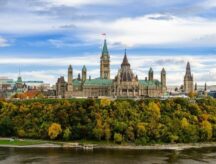Immigration to Canada declines in 2002
OTTAWA -- Immigration to Canada fell by about 8.5% between 2001 and 2002, says a new study, adding the downward trend was most significant in Toronto, which barely retained its position as the top North American destination for newcomers.
But the decline illuminates a wider problem than simply a drop in the number of immigrants to Canada's largest city, one legal expert suggests.
The study, he believes, signals a growing inability in the federal immigration department to process visa applications from skilled workers quickly during the last two years.
"What he, really, is a breakdown in the delivery system in Canada in 2002," David Cohen, a Montreal immigration lawyer, said yesterday. "It's not that there's less of a demand. There's been less of an ability to deliver. What [the study] is saying is the system got gummed up."
The study by the Association for Canadian Studies, a Montreal-based think-tank, looked at various aspects of immigration to Canada: comparing overall numbers in the last three years with those in the United States, and considering where immigrants to the two countries have come from.
It also reported a decline in the number of Canadians taking up residence in the United States, something the association suggested might be a result of poorer economic conditions south of the border.
Among its main findings, the study said 229,091 people immigrated to this country in 2002, according to figures provided by Citizenship and Immigration Canada. In 2001, there were 250,484 immigrants and 227,346 in 2000.
By comparison, the United States received 1,063,732 immigrants in 2002, according to the U.S. Department of Immigration and Naturalization Services, down slightly from 1,064,308 in 2001, but well above the 849,807 new arrivals in 2000.
For the fourth consecutive year, the study said, Toronto was the prime destination for immigrants to North America in 2002. Close to 111,500 new immigrants went to Toronto in 2002, down from 125,000 in 2001.
During the same period, the number of new, legal immigrants to Los Angeles -- a city with a high number of illegal immigrants -- rose to 108,600 in 2002 from 99,000 in 2001, threatening Toronto's previously secure position as the preferred destination for immigrants to the continent.
"Toronto is unique in North America and that uniqueness is a little bit less now," said Roderic Beaujot, a sociology professor at the University of Western Ontario in London, Ont., adding the study couldn't prove by itself that Toronto was less popular.
"We think of American cities, partly because they're so big, as receiving a lot of immigrants," Mr. Beaujot said. "But Toronto is in that league, if not above it."
Much of the overall decline in the number of immigrants to Canada between 2001 and 2002 was attributed to the fall in the number of people accepted from Asia and the Pacific region, the study said. Almost 119,000 people from Asia and the Pacific moved to Canada in 2002, 14,000 fewer than in the year before.
Those figures surprised Jack Jedwab, executive director of the think-tank, because they seemed to suggest that, after a decade of increasing immigration to this country, Canada had partially shut its door to newcomers.
Mr. Jedwab said such a phenomenon would run counter to other indicators that suggested the United States, rather than Canada, was looking less favourably on immigrants. "In the United States," he said, "all the polls indicate a diminishing of openness."
But Mr. Cohen wasn't taken aback by the study and he connected it to problems in the immigration system.
Canada was faced with a growing backlog of skilled workers applying to come to this country in the last several years, he said.
The government could have taken a number of approaches to the problem, he added -- eliminate the backlog by hiking its annual immigration targets, allow the delays to continue, or raise the standard newcomers would have to meet to qualify for visas and apply it retroactively.
In June, 2002, Ottawa took the third option, imposing new immigration rules and extending those rules back six months.
But the government landed in hot water when Immigration Minister Denis Coderre told Parliament there were only 30,000 people waiting to be processed when, in fact, there were actually 120,000.
After more than 1,000 families went to court demanding their cases be considered under the old immigration rules, a federal court judge last month issued an injunction that prevented Ottawa from using the new rules to reject people who had applied for visas before Jan. 1, 2002.
That decision is only the latest development in a chain of events that can be traced back to mid-2001, when the Immigration Department began to slow processing of applications from skilled workers as it anticipated the coming of the new immigration rules, Mr. Cohen said.
"The government has been unable to deliver visas in a timely fashion," he added. "It's kind of like a funnel. We've blocked the end of the funnel entrance now."
But a spokeswoman for Citizenship and Immigration Canada dismissed Mr. Cohen's claim, saying the high immigration totals in 2001 were a result of Ottawa exceeding its pre-set targets in an effort to reduce backlogs.
In 2002, the government targeted 210,000 to 235,000 immigrants and met those goals, Susan Scarlett said.
- Do you need Canadian immigration assistance? Contact the Contact Cohen Immigration Law firm by completing our form
- Send us your feedback or your non-legal assistance questions by emailing us at media@canadavisa.com



